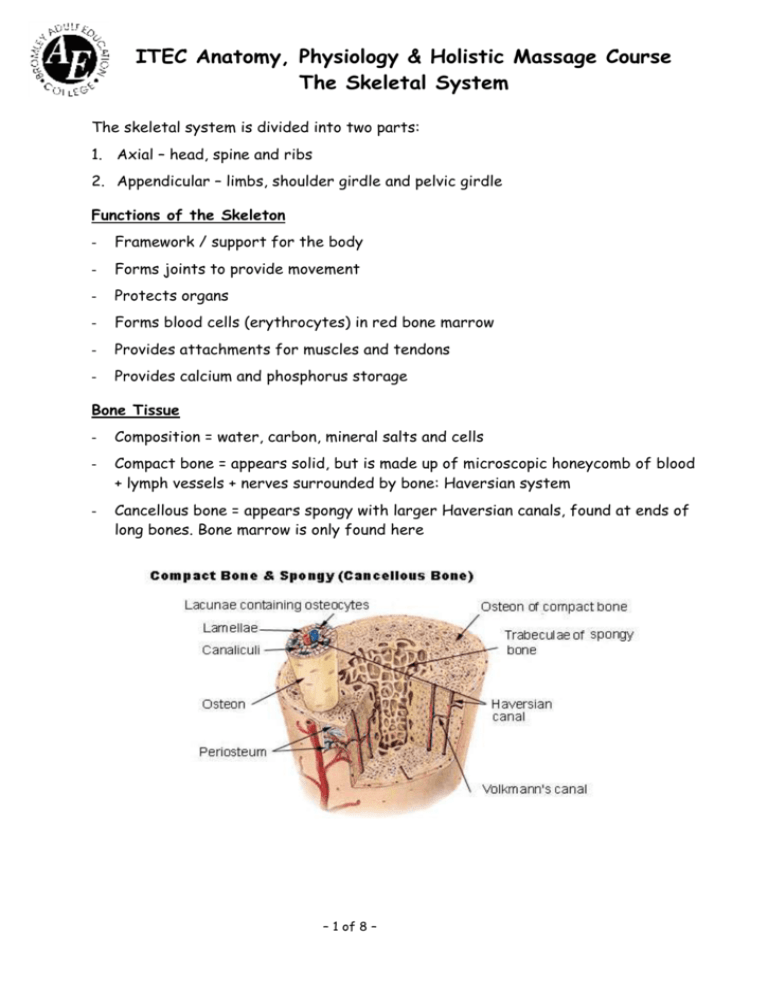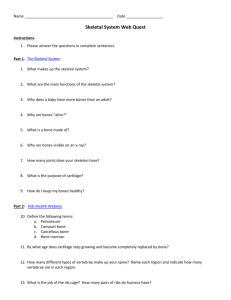1 - BAEC Intranet
advertisement

ITEC Anatomy, Physiology & Holistic Massage Course The Skeletal System The skeletal system is divided into two parts: 1. Axial – head, spine and ribs 2. Appendicular – limbs, shoulder girdle and pelvic girdle Functions of the Skeleton - Framework / support for the body - Forms joints to provide movement - Protects organs - Forms blood cells (erythrocytes) in red bone marrow - Provides attachments for muscles and tendons - Provides calcium and phosphorus storage Bone Tissue - Composition = water, carbon, mineral salts and cells - Compact bone = appears solid, but is made up of microscopic honeycomb of blood + lymph vessels + nerves surrounded by bone: Haversian system - Cancellous bone = appears spongy with larger Haversian canals, found at ends of long bones. Bone marrow is only found here – 1 of 8 – ITEC Anatomy, Physiology & Holistic Massage Course The Skeletal System Bone Types There are 206 bones in the body, divided into 5 types: 1. Long bones (eg femur – allows movement (levers) 2. Short bones (eg tarsals – strong groups of small bones in areas requiring little movement) 3. Flat bones (eg scapula – protection) 4. Irregular bones (eg vertebrae – shapes only found at one location) 5. Sesamoid bones (eg patella – formed in tendons) – 2 of 8 – ITEC Anatomy, Physiology & Holistic Massage Course The Skeletal System Types of Joint – articulation: - Fixed/fibrous/synarthroses – no movement (eg skull, pelvic girdle, teeth) - Slightly moveable/cartilaginous/amphiarthroses – movement only by compression of cartilage (eg vertebrae) - Freely moveable/synovial/diarthroses (5 types) – ball and socket (eg shoulders); hinge (eg elbow); pivot (eg neck); gliding (eg tarsals/metatarsals); saddle (eg wrist) – 3 of 8 – ITEC Anatomy, Physiology & Holistic Massage Course The Skeletal System Position of Bones in the Skeleton Cranium – encloses and protects the brain. 8 flat bones: - Frontal (1) – forehead and bony projections under the eyebrows - Parietal (2) – top and sides - Temporal (2) – sides and lower part - Ethmoid (1) – below frontal bone, in front of sphenoid bone. Part of nasal and eye cavities - Sphenoid (1) – base of skull, butterfly shaped - Occipital (1) – back of skull, contains hole (Foramen Magnus) which allows spinal cord access Facial – bones of the face. 14 bones: - Mandible (1) – lower jaw, chin and sides of face - Maxilla (2) – upper jaw, all other facial bones join onto it except the mandible - Palatine (2) – bottom of nose and eye cavities and roof of mouth - Zygomatic (2) – cheekbones - Lacrimal (2) – small bones behind nasal bones in eye sockets - Nasal (2) – bridge of nose - Vomer (1) – thin, flat bone separating nasal cavities - Turbinator (or inferior conchae) (2) – thin curved bones inside nasal cavity - Hyoid – not specifically part of the skull, but works with the mandible and temporal bones. It is not attached to any bones, but is suspended in the mid-neck region above the larynx – 4 of 8 – ITEC Anatomy, Physiology & Holistic Massage Course The Skeletal System Vertebrae – extended from the skull to the pelvis. 26 irregular bones: - Cervical – 7 neck bones. The first 2 (atlas & axis) are different to the rest and allow the head to nod and move from side to side - Thoracic – 12 bones supporting the ribs. They are larger than cervical vertebrae - Lumber – 5 bones of the lower back. The largest vertebrae - Sacrum – 5 fused bones of the pelvis. - Coccyx – 4 fused ‘tail’ bones. Ribs – thoracic cavity. 12 pairs of bones protecting the heart and lungs: - True ribs - first 7 pairs, also attached to the sternum - False ribs – next 5 pairs, only attached indirectly to the sternum or ‘floating’ Shoulder Girdle: - Scapula (2) – shoulder blades. Triangular, flat bones. Each has an ‘acromion process’ connecting to the clavicle and a ‘corocoid process’ which anchors to arm muscles - Clavicle (2) – collar bones. Slender, curved bones attached to the sternum and scapula - Sternum (1) – breast bone. Lies in front of the thorax. Made up of the top part (manubrim), mid part (body of sternum) and lower part (xiphoid process) – 5 of 8 – ITEC Anatomy, Physiology & Holistic Massage Course The Skeletal System Upper Limbs – arm and hand. 30 bones: - Humerous – long bone. Rounded end fits into the glenoid cavity of the scapula - Ulna – medial bone of the forearm on the little finger side - Radius – lateral bone of the forearm on the thumb side. When the hand rotates the palm backwards, the distal end of the radius is medial to the ulna - Carpels (8) – wrist bones. 2 rows of 4 bones: Upper row: scaphoid, lunate, triquetral, pisiform Lower row: trapezium, trapezoid, capitate, hamate - Metacarpals (5) – palm bones. The heads of the metacarpals form the knuckles - Phalanges (14) – finger and thumb bones. 2 in each thumb, 3 in each finger. Pelvic Girdle – weight bearing bones that protect the organs: - The ilium (2) (rim of hip), ischium (2) (sitting bones) and pubis fuse to form the hips - Innominate bones connect with the sacrum, coccyx and pubis – 6 of 8 – ITEC Anatomy, Physiology & Holistic Massage Course The Skeletal System Lower Limbs – Leg and foot. 26 strong weight-bearing bones: - Femur - thigh. The proximal end is ball shaped. The neck of the femur is a common fracture site - Tibia - shin. The largest of the 2 bones of the lower leg - Fibula – runs alongside the tibia - Tarsals (7) – join the foot to the leg and calceneous (heel): navicular, tarsus, cuniforms (lateral, intermediate and medial), and cuboid - Metatarsals (5) – sole - Phalanges (14) – toes. Each toe has 3, except for the big toe that has 2 - Patella – kneecap. Set into the tendon of quadriceps Terminology – used for skeletal and muscle work Anterior – front of Bicipital – 2-headed (femur, humerous) Condyle – rounded projection (pelvis) Costal – pertaining to the surface of ribs Distal – furthest end from mid line Lateral – away from mid line (movement) Medial – towards mid line (movement) Proximal – nearest to trunk Process – a projection of bone (eg spinal process) Shaft – main part of bone Trochanter – a large, blunt process (eg ball of the hip joint) Tuberosity – larger and broader process than trochanter (eg shoulder) – 7 of 8 – ITEC Anatomy, Physiology & Holistic Massage Course The Skeletal System Postural Deformities Causes: congenital, environmental, trauma Types: Kyphosis – exaggerated dorsal curve (hunched upper spine) Scoliosis – sideways curvature of the spine (S-shaped spine) Lordosis – exaggerated lumber curve (stomach protrudes as lower back pushes forward) Fractures and Their Causes Simple = clean break (no skin penetration) Greenstick = incomplete break (no skin penetration) Compound = broken ends of bone protrude through soft tissues and skin Complicated = breaks which also damage surrounding tissue Comminuted = bone breaks into many pieces Impacted = bone ends forced into each other Causes = most breaks are caused by trauma that twists or smashes bone (eg sports, car accidents, etc) Diseases/Disorders Osteo-arthritis Inflammation of the joints. May be due to injury or ageing. Cartilage breaks down, wear and tear to weight bearing joints. Pain and muscle weakness. Rheumatoid arthritis Chronic local progressive inflammation of synovial joints, blood vessels, heart and skin. The cause is unknown. Pain and muscle weakness. Gout Deposition of sodium urate crystals in joints and tendons. Acute local inflammation. Occurs when blood uric acid is very high due to kidney problems. Osteoporosis Reduction of total bone density. Bones tend to fracture more easily. Stress Mental stress can lead to muscle tension, which can cause poor posture. RSI Excess strain placed upon joints due to many repetitions of the same movement Carpal Tunnel Syndrome Incorrect/too firm a grip causing nerve damage to the hand – 8 of 8 –









